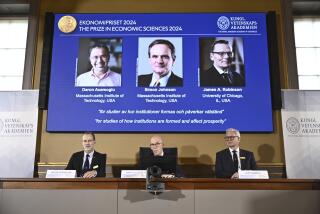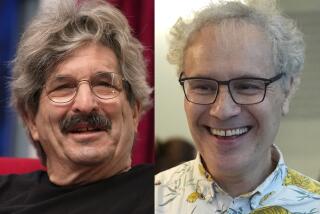Nobel Prize for Medicine Goes to UC Scientist
- Share via
An intensely single-minded and controversial UC San Francisco medical researcher received the 1997 Nobel Prize in Physiology or Medicine on Monday for discovering an “entirely new genre of disease-causing agents” responsible for exotic brain disorders such as mad cow disease and its human equivalents.
Dr. Stanley B. Prusiner, 55, a neurologist and biochemist, was awarded the prize for his pioneering work on an infectious particle that he named a “prion” in a landmark 1982 study. Way out on an intellectual limb, Prusiner argued that prions break the most basic rules of biology: Unlike bacteria and viruses, a prion (PREE-on) consists only of a protein fragment that manages to reproduce and spread although it has no genetic material of its own, such as DNA.
That “sensational hypothesis,” as the Nobel announcement called it, was so unorthodox at the time that it brought Prusiner heavy criticism and even ridicule from fellow scientists, with cruel limericks about “a Young Turk named Stan” circulating among experts.
But in dozens of experiments over the last 15 years, he and his often far-flung co-workers established the existence of prions--and showed that the particles were more paradoxical than originally imagined.
Among other dogma-defying aspects, it turns out that normal human brain cells contain a “healthy” version of prion proteins that can, like Jekyll becoming the evil Hyde, be transformed into a pathological prion. This in turn can give rise to a variety of wasting brain diseases in animals and people. Many researchers believe that Alzheimer’s disease, among other nerve disorders, may be caused by a similar mechanism.
The Nobel is Prusiner’s “final vindication,” said Dr. Daniel Perl, a director of neuropathology at the Mt. Sinai School of Medicine in New York City and an old friend. “He ran into tremendous resistance in the beginning. But the breadth and depth of what he has done and published is monumental.”
Prusiner, commenting on the slings and arrows that critics have fired at him over the years, said in a telephone interview Monday that he never considered giving up. “Science is about the systematic collection of data and the interpretation of that data,” he said.
“You have to be forceful, you have to be aggressive, you have to be pushy. Nobody does well in science unless he has those traits. I don’t know any scientists who don’t push, and some push harder than others.”
*
It was the first time in 10 years, and only the fifth time since 1960, that the medical Nobel was awarded to just one person. Prusiner will receive the $1 million that comes with the prize at the ceremony in Stockholm on Dec. 10. He said that he had no plans yet to spend the money other than to pay taxes on it.
“His work has turned a once obscure corner of medicine into an important source of new ideas about fundamental biological mechanisms,” said Zach Hall, the director of the National Institute for Neurological Disease and Stroke, which has partially funded Prusiner’s research since 1975.
A UC San Francisco co-worker, Fred Cohen, said Prusiner’s career is “an example of how perseverance, together with an intense focus on a problem, can lead to results.”
Dr. Bruce Miller, a neurologist at the UCLA School of Medicine and an official with the John Douglas French Alzheimer’s Foundation, which has supported Prusiner’s research, said that initially “almost no one believed [the prion theory] because it went against conventional thinking. But increasingly the scientific community thinks that this model of prion disease has relevance to understanding Alzheimer’s and many other degenerative diseases.”
*
Prusiner has said that he became interested in exotic neurodegenerative ailments in 1972, after having a patient with Creutzfeldt-Jakob disease, a form of progressive dementia that strikes about one out of a million people. Researchers at the National Institutes of Health and elsewhere had shown that the disease bore a striking similarity to certain infectious brain-wasting diseases in animals, particularly scrapie in sheep and bovine spongiform encephalopathy, or mad cow disease. And scientists at Hammersmith Hospital in London had suggested that the so-called scrapie agent might be a protein particle naked of genetic material that could cause disease.
Prusiner expanded on those early leads. In his first experiments, he showed that scrapie could be transmitted to hamsters and that the “prions,” as he dubbed them, appeared to lack any genetic material. To biologists steeped in the knowledge that all disease organisms carry genetic material that guides their replication after they invade a host, that observation was roughly like discovering cars zipping along the freeway without engines.
Then, many experiments later, Prusiner and his co-workers proposed an answer to the question of how the prions multiplied, making what the Nobel Prize committee called a “sensational discovery.” Normal animal and human cells already harbor a non-pathological version of the prion protein, whose DNA genetic material is intertwined within those cells. But when those normal prions are triggered--and it isn’t known what the trigger is--their three-dimensional structure collapses and twists into a new, destructive shape.
“Prions possess an innate capacity to convert their structures into highly stable conformations that ultimately result in the formation of harmful particles,” the Nobel committee said in its prize citation. The particles are “the causative agents of several deadly brain diseases of the dementia type in humans and animals,” the committee added.
A great deal is not known about the intricate biology of prions, Prusiner said. In an article to be published later this week in the journal Science, Prusiner discusses his latest research and suggests that another, as yet unidentified protein fragment may be involved in the prion-disease process, which he calls “protein X.”
And to be sure, some researchers continue to doubt that prions are entirely free of genetic material, as he maintains. “There are still people who don’t believe that a protein can cause these diseases, but we believe it,” Lars Edstroem, professor of neurology at Sweden’s Karolinska Institute, which administers the Nobel Prizes, told Associated Press.
*
The most striking--and ominous--example of a prion disease is the recent epidemic of mad cow disease in Great Britain, where as many as a million cows have become afflicted with the brain-wasting disorder. At last count, 21 people there, most of them under 40, have developed a type of Creutzfeldt-Jakob disease that most researchers believe was acquired by eating beef from prion-infected cows. No such cases have been documented in the United States.
“There’s no immediate public health threat on the horizon,” Prusiner said of the U.S. situation. “But you never know what will happen.”
“There’s nothing magical about it,” Prusiner said of the often grueling research. “This is a huge body of information that has been accumulated. There has been a lot of hard work and a lot of fun and a lot of unexpected results along the way.”
The prizes are presented on the anniversary of the death of Alfred Nobel, the industrialist and inventor of dynamite whose will established the prizes. Recipients of the prize in other categories will be announced in coming days.
(BEGIN TEXT OF INFOBOX / INFOGRAPHIC)
A New Game of Germs
Dr. Stanley B. Prusiner of UC San Francisco was cited for his discovery of prions, a new genre of germs that causes mad cow disease and other brain-wasting diseases.
HOW PRIONS WORK
1. Prion proteins exist in the brain twisting into spirals (left). Such proteins are usually harmless.
2. But when they turn infectious, protein spirals stretch out (blue arrows). In time, this kills cells and eventually ravages the victim’s brain.






